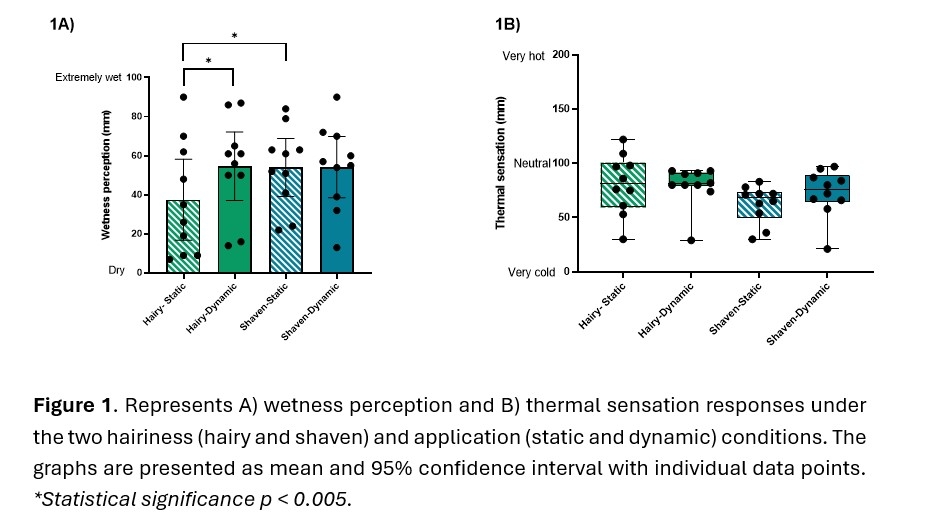Introduction
Experiencing wetness on the skin from sweating or contact with fluids has been repeatedly shown to induce thermal discomfort, which is a critical trigger of behavioural thermoregulation (Filingeri and Havenith, 2018, Gagge, 1937). An example is the common experience of wetness at the underarm resulting from thermal or psychogenic sweating. Millions of people apply antiperspirant deodorant products to the underarm to minimise this negative experience (Watkinson et al., 2007). Due to the lack of hygroreceptors, humans integrate thermal and mechanical inputs arising from the presence of moisture on the skin to perceive wetness (Filingeri and Havenith, 2015). Whilst our understanding of the neurophysiology of skin wetness perception (WP) is expanding (Typolt and Filingeri, 2020). There is limited research on how the structure of the skin, such as the presence of hairs, impacts local WP. This study aimed to investigate the impact of hair on local skin WP at the underarm to inform the design of antiperspirant deodorants.
Methods
Ten healthy males (21±2y; 182±12cm; 74±10kg) took part in a quasi-experimental trial, during which they underwent a quantitative sensory test of WP and thermal sensation (TS) on hairy (right-side) and shaven (left-side) underarm skin. Participants reported on a 100-mm visual analogue scale the perceived magnitude of WP (0=dry; 100=extremely wet) and TS (0=very cold; 100=neutral; 200=very hot) during repeated contact (5 applications) with a wet cotton patch (0.8ml of water; 1.32 cm2) secured on a temperature-controlled probe (23°C). Wet stimuli were applied either statically (10s) or dynamically (4x forward-backward motions), alternating between the hairy and shaven underarm. After normality testing, a two-way repeated measures ANOVA was used to examine main effects and interactions between hairiness (hairy vs. shaven) and mode of application (static vs. dynamic) on WP and TS.
Results
There was a statistically significant interaction between hairiness and mode of application on WP (F=6.037, p=0.036, Fig.1A). Post-hoc analyses indicated that a) WP increased from static to dynamic application under hairy conditions only (+19mm; [95%CI 6, 32]; p=0.008) and b) WP were greater between static application under shaven vs. hairy conditions (+18.5mm [95%CI 1.5, 35.5] p=0.036). No differences in WP were observed between dynamic application under hairy vs. shaven conditions (+0.4mm; [95%CI -6.2, 7.0]; p=0.894).
Additionally, there was no statically significant main effect of application (F=2.275, p=0.166), nor hairiness (F=4.167, p=0.072) on TS (Fig.1B); although we note that TS was coldest under static shaven conditions (10mm, 95%CI: -2, 23) and the least cold under static hairy conditions (1.5mm, 95%CI: -14, 17).
Conclusion
The study demonstrated that, the presence of hairs can increase WP during dynamic stimulations, although the resulting WP was not greater than that experienced during static or dynamical stimulation of shaven skin. This novel evidence indicates that under static conditions, hairs could act as thermal insulators and reduce WP; conversely, during dynamic application, hair movement provides mechanical cues that enhance WP to a level equivalent to that experienced with shaven skin. These insights could inform antiperspirant deodorant design that considers users’ shaving habits to enhance thermal comfort during application.

